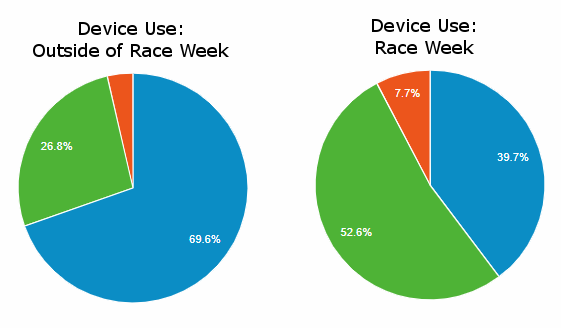When building out your website (or redesigning it), you’ll have to determine how to structure the content and prioritize it based on your key audiences. Which also means you’ll have to determine who your key audiences are. You don’t need (or even want) to build a website that speaks to everyone, but you do need your site to speak to the main groups that will be using it.
The basic roadmap of the process is: define your audience personas, prioritize your key audiences, and structure your content around those key audiences. Below is more detail on the process using the example of RacefortheRivers.org, a local non-profit event we created and continue to support through website updates and marketing efforts.
Step 1: Define Audience Personas
A persona is a representation of the type of person who will be visiting your website. It doesn’t cover all people in a group or all aspects of each individual in the group, but it does address their most representative qualities.
“The purpose of personas is to create reliable and realistic representations of your key audience segments for reference. These representations should be based on qualitative and some quantitative user research and web analytics.” – Usability.gov
Start by brainstorming a list of who you think uses your website. Be sure to get input from other people in your organization—they might have additional insights based on who they interact with.
For Race for the Rivers, the list might be:
- Racers
- Vendors
- Sponsors
- Festival-goers
- Volunteers
- Media
Now back up your list with data. Log in to your Google Analytics account and look at the demographics of your site’s current visitors. You can also install a tool like Inspectlet on your site to watch visitor sessions. And if you have the time and budget, you can conduct interviews with your audience.
The result should be a thorough list of who your site’s visitors are. Here is a detailed example of personas from the National Archives (NARA) for inspiration!
Step 2: Prioritize Key Audiences
Now that you have a list of your personas, it’s time to prioritize them by their importance to your site’s overall goal. For Race for the Rivers, here are the primary, secondary, and tertiary audiences:
Primary Audience: Racers
You can’t have a race without racers! They need to be able to get race information easily so they can register, pledge, and plan for race day accordingly. This year’s race date should be prominent, and the overall fun and importance of the race itself should be present throughout the site—not only is this information crucial to the racer, it is important for all other personas as well, so making it primary content accomplishes that for everyone.
Secondary Audiences: Vendors, Sponsors, and Volunteers
You also can’t have a race without support! While each of these personas is crucial to the race itself, they are classified as secondary audiences because we don’t want the website to speak primarily to them—it would overshadow the fun and importance of the race itself. But these users do need a clear path to get the information they need.
Tertiary Audiences: Festival-goers and Media
The people who attend the festival on race day are a key part of the day’s fun! They learn about the importance of keeping our rivers clean, they cheer on the racers, and they purchase food, beverages, and products from our vendors. The media helps get the word out about our race, which we greatly appreciate. However, these are both considered tertiary audiences of the website because, like the secondary audiences, we don’t want this content to overshadow the race itself.
Prioritizing personas for your website is not the same thing as prioritizing their importance to your organization! At Race for the Rivers, we value everyone who contributes and couldn’t have a race without them. But in order to effectively communicate with all these audiences on the website, we have to prioritize the content based on their roles and how they are likely to interact with our site.
Step 3: Structure Content Around Key Audiences
Now that we have our key audiences prioritized, we can structure our content around it. While it’s tempting to place everything “above the fold,” remember that when users are faced with too many decisions, they often make NO decision and simply leave your site.
“Presenting users with too many choices at once can lead them to take the cognitively easy route and not make any decisions at all, leaving your site entirely.” – Optimizely.com
Organizing your content in an intuitive way—even if that means some of it is tucked away behind a click or below a scroll—can actually help your users (and your conversions).
For Race for the Rivers, here’s how we structured some of the content:
- Home Page: The home page has messaging and imagery that speaks to all audiences, and prominently displays the date since that’s something each audience segment needs. However, any time a decision of priority needs to be made, the race itself comes first. For example, in the photo collage, there are more photos of racers than of vendors, sponsors, and the festival. In any lists or ordered content, the race comes first, then the festival and other content.
- Navigation: The main menu on the site places the race first, then the festival, then the cause. A separate utility menu allows one-click access to registration, pledges, and login for the racers.
- Devices: For most of the year, the site is accessed primarily via desktop: 70% of users are on desktop, 27% mobile, and 3% tablet. But during race week, mobile jumps to 53%, tablet increases to 8%, and desktop drops to 40%. We designed the site to be mobile-friendly year-round and made sure that content was easy to access from a mobile device. Right before the race, we also email all racers a Race Day Packet so they have the most important and up-to-date information all in one handy place on their phones.

Key Takeaways
Following this roadmap when designing or redesigning your website will help you prioritize content, which helps you make decisions on site structure, calls-to-action, and the visual layout of your site.
A few points to remember:
- You’re not hurting anyone’s feelings by saying they are a secondary or tertiary audience—they won’t even see your personas! You are simply prioritizing their involvement with the site, which enables you to better organize content for ALL users.
- Pulling data helps you make informed decisions. It’s OK to start with your gut instinct (e.g. who you think are your site’s users), but it’s best to find data to back that up. Install Google Analytics and Inspectlet now to start collecting data.
- Feel free to space out your content and focus on your primary audience first. If everything is organized properly, your secondary and tertiary audiences will find the content they need. Placing all content in one area actually works against you, making it too cluttered for anyone to find what they need.
We hope these tips help you as you start thinking about organizing your website’s content. We go through this process as part of our Discovery & Planning stage when designing websites, so we’d be happy to help on your next project!
